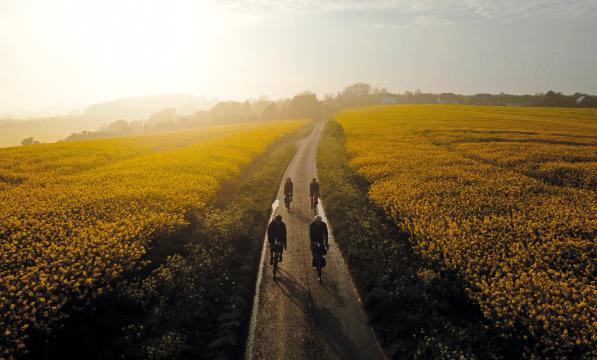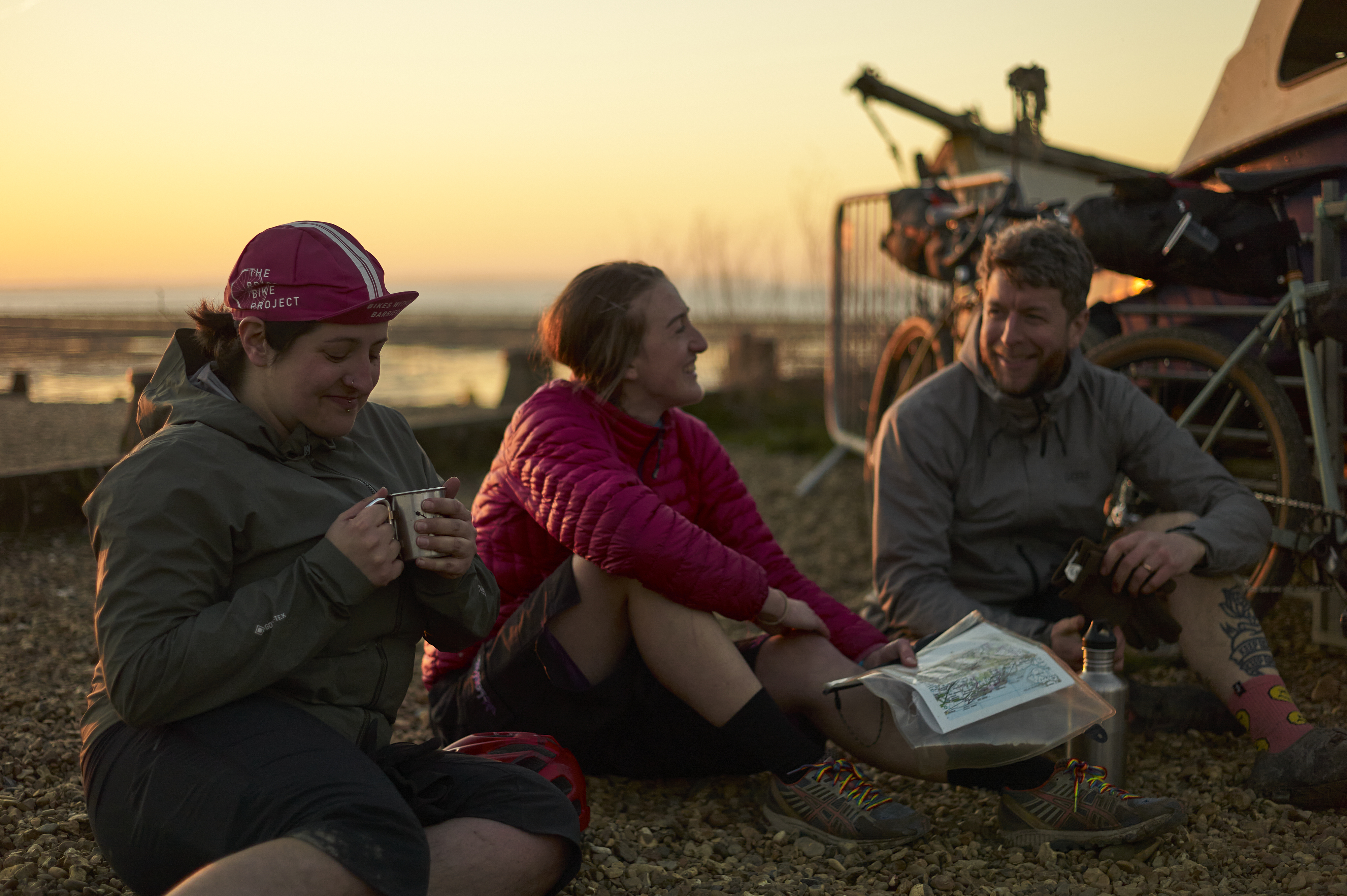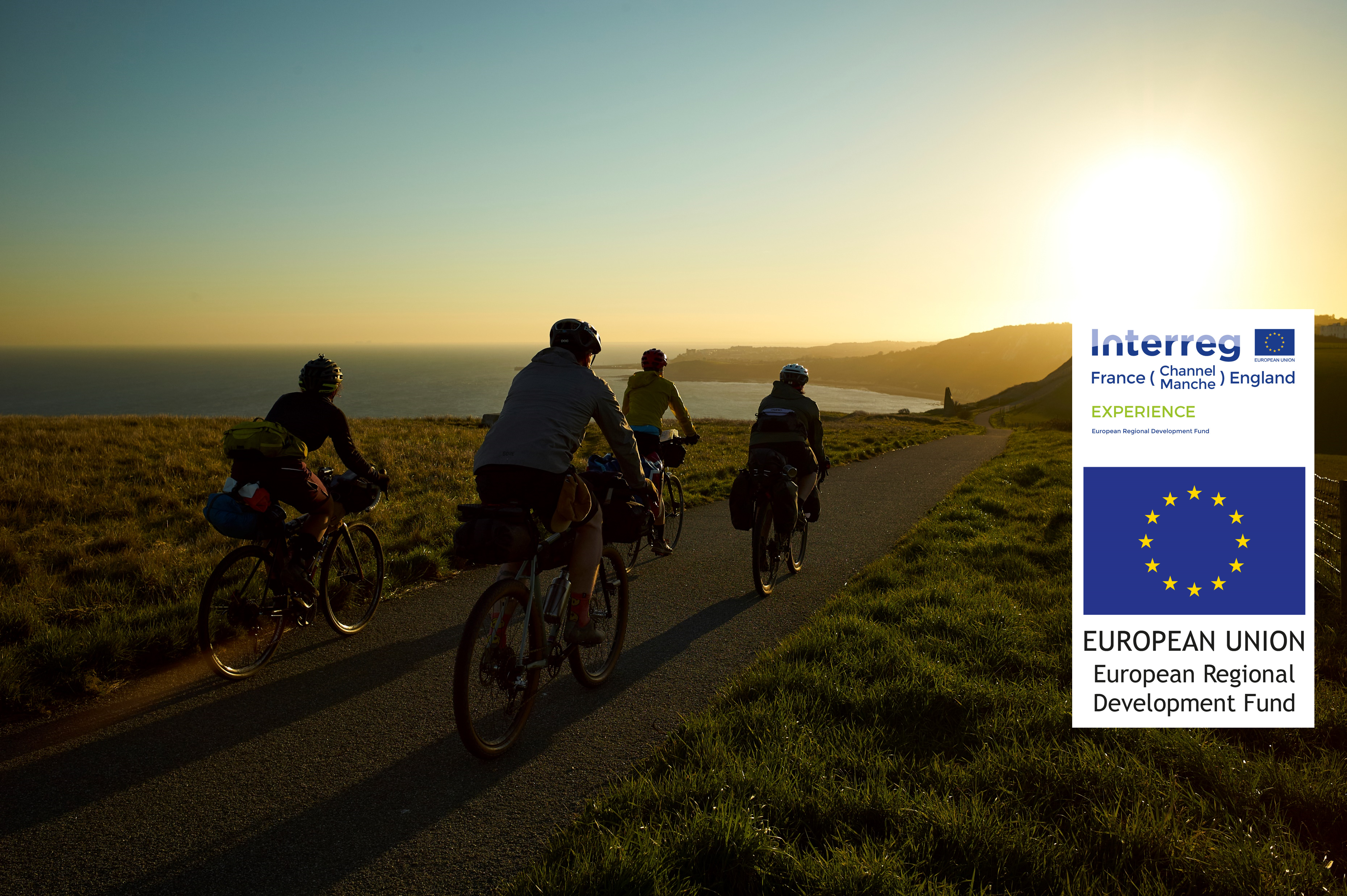Great Rides: Cantii Way

Where: East Kent Start/finish: Wye, but anywhere on the route works Distance: 158 miles Photos: Jordan Gibbons and Stefan Amato from Pannier.cc
"You’re going up to Etchinghill now?” The waitress at Folkestone’s Harbour Arm looked aghast at us. “Ooh, that’s a big hill that is, that’ll be hard work.” Looking outside at the trees swaying in the darkness from our haven of light and warmth, we were tempted to ask if we could sleep inside under the tables in return for washing up. In fact we did ask, only half joking.
By the time she returned to clear our plates, our waitress seemed to take pity on us and considered that perhaps she had exaggerated slightly. The hill wasn’t that big.
She was right the first time. It was a big hill. However, the return for our efforts was an impressive view over the lights of Folkestone before we reached our beds for that night, with the blazing beacon of the Channel Tunnel terminal doing its best to dominate the scene.

A Cantii break
We were test-riding Cycling UK’s new long-distance route around east Kent, the Cantii Way. Beginning in the village of Wye in the Kent Downs Area of Outstanding Natural Beauty, the route meanders along the River Stour past Canterbury to Whitstable, circles the coast all the way down to Dungeness, then dips a toe into East Sussex (as we’d be strongly reminded later) to visit the mediaeval town of Rye before heading back inland.
Why the strange name with two ‘i’s? The Cantii Way is named after the Iron Age Celtic tribe that inhabited the area we now know as Kent. Julius Caesar encountered them on his abortive conquest of England in 54BC, describing the Cantii as “the most civilised” of the British tribes. It is from them that the county of Kent and city of Canterbury both derive their names.
Our merry band consisted of myself and Rob Spanring from Cycling UK, Jordan Gibbons from Pannier wielding the camera, Will Meyer from Brother Cycles, cycling journalist Mildred Locke, and all-round adventurer (and our #12nightsoutin1year ambassador) Vedangi Kulkarni.
Assembling at midday at a lovely café in Wye, we fuelled ourselves far more than was necessary considering we only had 26 miles to ride that afternoon. It’s wonderful little gems like this café that we want to support and promote with our Cycle Friendly Places accreditation, to help them attract more visitors with bikes.
We started to regret those enormous pieces of cake as we were faced with a bonus climb to start the day, having decided that we really couldn’t miss the panoramic views from above the Wye Crown before we set off. The chalk crown sits proudly on the hillside above Wye, marking the beginning of our route. It was created in 1902 to mark the coronation of King Edward VII, and took 35 students more than four days to move 7,000 barrow loads of turf, soil and chalk to make it.

North Downs Way
After that scenic detour, we swooped down into the valley only to climb straight up the other side to the King’s Wood. This was a beautiful start to the route, with the sunlight glinting through the trees as we rolled along the wide gravel tracks. Here the Cantii Way joins part of the North Downs Way National Trail, which runs for 153 miles from Farnham in Surrey to Dover and Folkestone in Kent.
Only parts of the North Downs Way National Trail are open to cyclists, so in 2018 Cycling UK proposed a riders’ route that could be cycled from end to end, by linking the rideable sections of the trail with bridleways, byways and quiet stretches of road. We’re now working in partnership with the Kent Downs Area of Outstanding Natural Beauty and the North Downs Way National Trail manager to develop this as an official alternative route for the National Trail, as part of the EXPERIENCE project.
It wasn’t long before we were on more urban cycle paths, following streams of students through Canterbury past the University of Kent, to join the Crab and Winkle Way to Whitstable. This old railway line closed in 1952 but it took until 1997 for it to be converted to a cycling and walking path. It now makes for a flat and pleasant ride out to the coast, where we reached Whitstable just in time for a gorgeous pink and orange sunset out over the sea.
With several members of our party intent on sampling its famous oysters, we headed to the Whitstable Oyster Co. for dinner, belatedly realising that it was a rather upmarket establishment and we felt a little underdressed. In the candlelight, Will remarked that it was the most romantic meal he’d ever had on a bikepacking trip. We couldn’t disagree – even if most of us had only met each other that morning.

Over to Dover
The following morning gave us more lovely sunshine, accompanied by a bracing headwind. We kept reasoning to ourselves that if we were curving around the coast, at some point it must become a tailwind. It became a mantra for the day: “We’ll turn right soon!”
Slowly but steadily, we made our way towards the towers at Reculver Roman Fort, hazy in the distance. From there we had two options: continue along the busy coastal paths around the Isle of Thanet past Margate and Ramsgate, or a quieter inland shortcut. The choice was already made for us: we had an appointment with Mildred’s mum who lives slap bang on the inland route, and was waiting to welcome us with coffee and biscuits (and a ticking-off for Mildred for not visiting more often).
Suitably replenished, we rolled on past some fabulous houses to reach the coast again. Fitting as it would have been to stop for a sandwich in Sandwich, we pressed on to Deal. Earlier in the day we had been contemplating pausing for a dip in the sea at Deal. As we huddled on the windy beach by the pier clutching our lunch, with gulls circling menacingly overhead, no one had the urge to reach for their swimming costumes.
It was at this point that Jordan emerged from a gift shop with a paper parcel and a devilish grin, explaining that he’d bought a lovely gift for his old friend Will. From the paper appeared our new mascot for the trip: a garishly painted wooden Pinocchio toy with an undeniably creepy expression. Will was not overwhelmed with gratitude as he puzzled over how to strap this unnecessary baggage to his bike. Pinocchio ended up perched precariously on his handlebars, smiling blankly at bemused passers-by.

Approaching Dover, we encountered the main hills of what had been a predominantly flat day. We tested out one of the most stunning paths of the trip, a motor traffic-free track past South Foreland lighthouse above the cliffs east of Dover. Unfortunately we aren’t yet able to include it in the Cantii Way route but Cycling UK is in discussion with the National Trust and Sustrans about moving the NCN route (and the Cantii Way) from the road to this well-surfaced track, which provides an impressive view over the port at Dover.
Plummeting down past Dover Castle, we then had to climb back up onto the cliffs on the Chalk and Channel Way. We passed a couple of sound mirrors, concave concrete structures which were used to pick up faraway sounds during WWII by highly trained interpreters. There are a lot of reminders of military history along this stretch of the route. We spotted a Battle of Britain memorial and pillboxes silhouetted against the golden evening sky.
Our only battle that evening would be with the aforementioned hill out of Folkestone, to reach the farmhouse B&B at Beachborough Park. Just as Pinocchio was being settled on the mantelpiece to watch over us as we slept, the electric lights started to flicker slightly. A slight shiver went down my spine – it felt like the beginning of a horror film…

Dungeness and flagons
Fortunately we all awoke safe and sound. Circling around Folkestone, we dropped down to the coast again to cruise along more coastal promenades to Kent’s south-eastern point at Dungeness.
Dungeness National Nature Reserve is a unique and peculiar place. It’s the largest expanse of shingle in Europe, and while it may appear empty and desolate, it’s a rare habitat for a large number of plant and bird species. In this sparse landscape sit several incongruous sights, including a miniature railway, the hulking grey mass of a nuclear power station, wooden fishing cabins converted into houses, and the amazingly popular Dungeness Fish Shack. It’s one of the strangest places that I’ve ever been.
Passing the beach at Camber Sands, the wind had dropped and we felt we really ought to manage a swim. Despite the sunshine, the incredibly cold water reminded us in no uncertain terms that it was only mid-March. Thankfully there was a coffee hut with excellent cake to fortify us afterwards. It wasn’t long before we were climbing through the majestic mediaeval archway into Rye and exploring the pretty cobbled streets. We made the mistake of saying to a curious local that we were doing a tour of Kent and he indignantly responded that we were in East Sussex now. The fortified town of Rye, he said, “has been defending itself from invaders trying to claim it for centuries!”

We made our apologies and beat a hasty retreat for our final section of the day, a loop around Rye Harbour Nature Reserve. It felt magical in the hazy golden light as we watched our shadows stretch away from us towards the sea glimmering with pink and orange.
We were staying that night at the Charles Palmer Vineyard near Winchelsea, which had kindly offered a place to pitch camp in their field. This was our only night sleeping outdoors, and as the temperature dropped during the final miles the prospect became less and less appealing. We were lucky, however, that the owner of the vineyard took pity on us and opened up the wine tasting room for us to sleep on the floor, with the luxuries of a rug and a wood-burning stove. Of course, it was only polite to buy a bottle to sample while we were there. Jordan took it one step further and ambitiously decided he could take two home as gifts if he squeezed one in each of his fork bags.

Garden of England
The morning coated everything in beautiful sparkling frost, and the bitter cold made us very thankful to have slept in a cosy room (especially those who only had bivvy bags). It soon warmed up as we set off for the final morning of riding, heading inland back to Wye.
It was a fairly straightforward route along winding lanes past old hop-drying oast houses, and along part of the military canal – until we found a bit of off-road excitement in the form of a byway through some lovely woodland, which was so muddy it was unrideable and a challenge enough just to slither along pushing the bikes. If it was this wet after fairly dry weather, we decided it was wise to remove this bit from the Cantii Way and use the road instead. This is what test rides are for!
From there it was easy rolling into Ashford, where a few of us split off to get a train home and the others carried on for the final few miles back to Wye. The wonderful thing about travelling by bike is that even our ‘Kent natives’ Mildred and Will reflected that they had seen parts of the county they had never discovered before, or hadn’t thought to visit. For the rest of us who weren’t so familiar, it was a wonderful leisurely exploration of the area’s fascinating history and modern-day character, and a chance to savour the flavours that earn it the title of ‘the garden of England’.

Experience project
As one of 14 partners on the EXPERIENCE project, Cycling UK is working to deliver sustainable new off-season tourism experiences, including long-distance routes like the Cantii Way and West Kernow Way. We’re also supporting businesses to attract cyclists with the Cycle Friendly Places accreditation. In September we’ll be launching a new route around Norfolk.
The €23.3 million project is co-financed by the European Regional Development Fund (ERDF, €16 million) through the Interreg VA France (Channel) England Programme 2014-2020, and aims to boost visitor numbers in six pilot regions including Cornwall, Norfolk and Kent.





